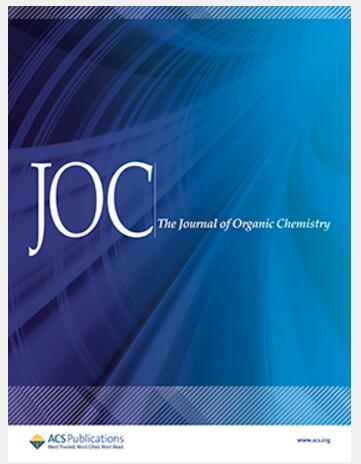铑催化环丙基功能化三取代烯烃的区域和对映选择性氢甲酰化的机理研究。
IF 3.3
2区 化学
Q1 CHEMISTRY, ORGANIC
引用次数: 0
摘要
不对称氢甲酰化(AHF)是将廉价原料烯烃转化为高附加值产品的一种有价值的方法。鉴于这些反应在当代的重要性,我们利用[Rh(R,S)- yanphos]催化的合成气(CO和H2)研究了环丙基功能化三取代烯烃的AHF机理,通过部署计算、动力学和光谱工具的组合,提供了高的区域和对映选择性。我们的综合密度函数计算表明,区域和对映体选择性源于不可逆的烯烃插入步骤,其中分支途径在向烯烃表面的关键迁移插入中表现出4.7 kcal/mol的显著能量优势。烯烃插入过渡态(TS)是决定转化率的过渡态,活性催化剂[RhH(CO)((R,S)-Yanphos)]是决定转化率的中间体,通向产物R对映体的途径的能长为19.9 kcal/mol。我们的动力学研究表明,在高转化率时,对烯烃有一级依赖性,对Rh催化剂有准一级依赖性。发现缓慢的催化剂活化比催化剂失活或产物抑制更可能发生。分子和能量细节可能有助于设计在AHF反应中利用三取代烯烃的新实验。本文章由计算机程序翻译,如有差异,请以英文原文为准。
Mechanistic Insights into Rh-Catalyzed Regio- and Enantioselective Hydroformylation of Cyclopropyl-Functionalized Trisubstituted Alkenes.
Asymmetric hydroformylation (AHF) is a valuable method to convert cheaper feedstock alkenes into value-added products. In view of the contemporary importance of these reactions, we have examined the mechanism of AHF of cyclopropyl-functionalized trisubstituted alkenes by using syngas (CO and H2) catalyzed by [Rh(R,S)-Yanphos], offering high regio- and enantioselectivities by deploying a combination of computational, kinetic, and spectroscopic tools. Our comprehensive density functional calculations suggest that the regio- and enantioselectivities originate from the irreversible alkene insertion step, where the branched pathway exhibits a notable energetic advantage of 4.7 kcal/mol in the key migratory insertion to the re face of the alkene. The alkene insertion transition state (TS) is the turnover-determining TS, and the active catalyst [RhH(CO)((R,S)-Yanphos)] is the turnover-determining intermediate, with an energetic span of 19.9 kcal/mol for the pathway leading to the R enantiomer of the product. Our kinetic studies revealed a first-order dependence on the alkene and a quasi-first-order dependence on the Rh catalyst at high conversions. Slow catalyst activation is found to be more likely than catalyst deactivation or product inhibition. The molecular and energetic details may help in the design of new experiments leveraging trisubstituted alkenes in AHF reactions.
求助全文
通过发布文献求助,成功后即可免费获取论文全文。
去求助
来源期刊

Journal of Organic Chemistry
化学-有机化学
CiteScore
6.20
自引率
11.10%
发文量
1467
审稿时长
2 months
期刊介绍:
Journal of Organic Chemistry welcomes original contributions of fundamental research in all branches of the theory and practice of organic chemistry. In selecting manuscripts for publication, the editors place emphasis on the quality and novelty of the work, as well as the breadth of interest to the organic chemistry community.
 求助内容:
求助内容: 应助结果提醒方式:
应助结果提醒方式:


